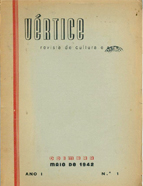

................................
Unlike what happened in Seara Nova, there were very few controversies dealing with historical issues in Vértice. Nevertheless, one that occurred in the early 1950s between Joel Serrão and Piteira Santos about Antero de Quental is worth mentioning, as it continued the controversies that had begun in Seara and involved several contributors. In a way, this controversy between Piteira Santos and Joel Serrão pitted the two historical conceptions mentioned above against each other, one with more civic and pedagogical aims and the other with a scientific orientation.
With regard to the central issue raised, the divergence had been latent since 1947, although care was taken not to specifically mention the names of those who held the different opinions. This caution ceased to make sense a few years later, in a context of open controversy between contributors to Vértice, particularly between João José Cochofel and António José Saraiva in the first half of the 1950s, known as the internal controversy of neo-realism.
In 1947, a number of articles denounced the rhetorical spirit that was present among young progressive intellectuals. Rui Feijó, supporting the ideas of an article published in Seara Nova by Rui Grácio, criticised this “rhetoric of the concrete”, which repeated “the need for concrete study, but only talking about it as a necessity without actually putting it into practice” (no. 43, Jan. 1947, 230). In the same vein, a few months later, Joel Serrão also expressed the same concern when he asked: “Are we really going to study our problems? Or will we rather believe that the national reality will be transformed by the magic touch of our good or bad rhetoric?” (no. 50, Sept. 1947, 353-5). In response to these positions, in an article entitled precisely “The rhetoric of the concrete and other rhetorics”, Piteira Santos valued “the attitude as an attitude”, that is, even if ideas did not materialise into deeper knowledge and effective reform of society, they were still real and consequential: “the ideas of men win men for ideas” (no. 55, March 1948, 236-7).
This work is financed by national funds through FCT - Foundation for Science and Technology, I.P, in the scope of the projects UIDB/04311/2020 and UIDP/04311/2020.
